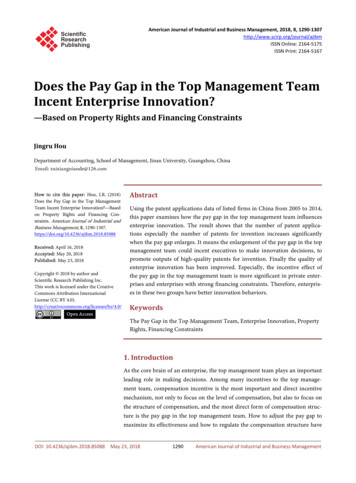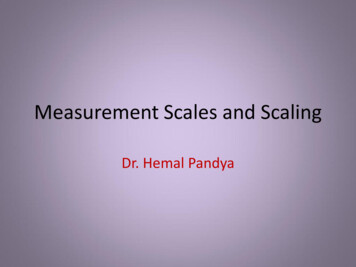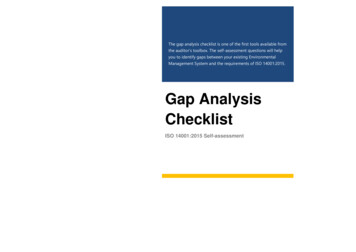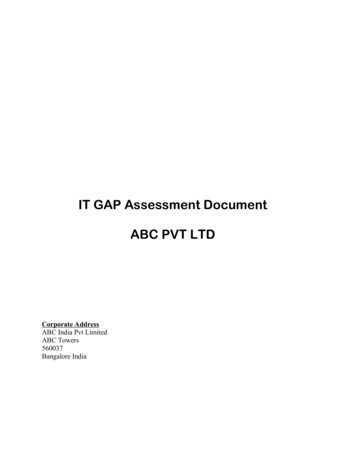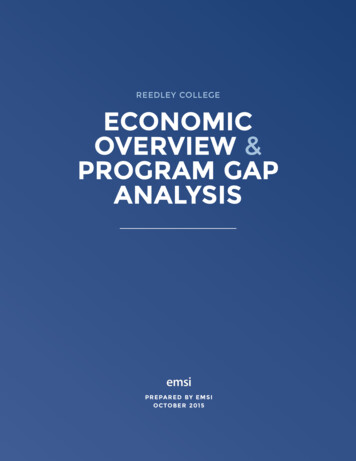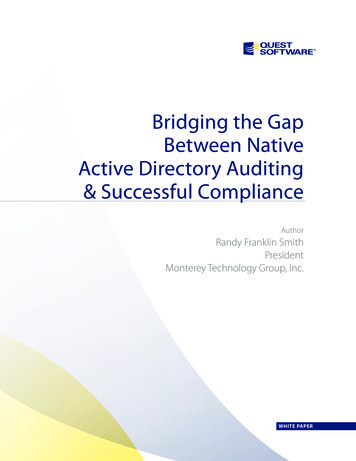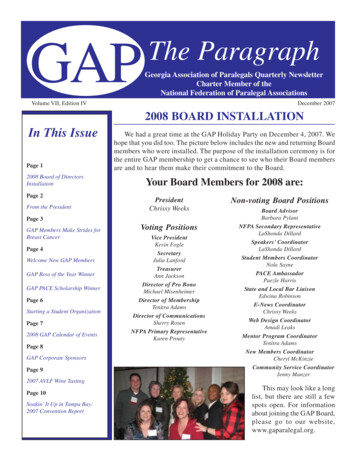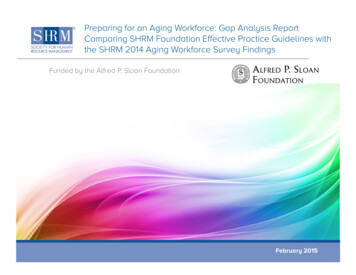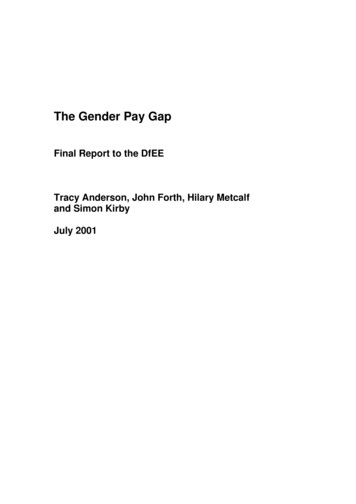
Transcription
The Gender Pay GapFinal Report to the DfEETracy Anderson, John Forth, Hilary Metcalfand Simon KirbyJuly 2001
ii
ContentsContents . iTables and figures . iiiExecutive Summary . ivIntroduction . ivTheories explaining the gender pay gap . vCauses of the gender pay gap . vi1 Introduction .12 Description of the gender pay gap .42.1 Introduction.42.2 Measurement of the pay gap: some considerations .42.3 Trends in the gender pay gap.72.4 Differences in the gender pay gap .132.5 Summary.203 Theoretical explanations of the pay gap .223.1 Introduction .223.2 Differences in individual characteristics: human capital theory .223.3 Differences in choice .233.4 Discrimination.243.5 The social value of skills.273.6 Crowding .283.7 Monopsony.283.8 Internal labour markets .293.9 Unionisation and pay-bargaining.303.10 Other contributory factors .313.11 Summary .324 Evidence from the UK.354.1 Introduction .354.2 Decomposing the gender wage gap.364.3 Individual characteristics .384.4 Job characteristics .514.5 Unionisation and wage setting .584.6 Payment systems and promotion .614.7 Discrimination.664.8 Gaps in our knowledge .694.9 Conclusions.705 The role of job and employer characteristics: an investigation using the 1998Workplace Employee Relations Survey .755.1 Introduction.755.2 Data and methods of analysis .775.3 Assessment of the data.795.4 Results .825.5 Conclusions.926 The role of commuting: an investigation using the Labour Force Survey966.1 Introduction .966.2 Background: possible reasons for gender commuting differentials .97i
6.3 Commuting patterns in Britain .986.4 Previous research .1036.5 Analytical approach.1056.5 The results .1066.7 Conclusion: commuting, wages and the gender pay gap .1107 The Gender Pay Gap: Conclusions .1127.1 Introduction .1127.2 The causes of the gender pay gap.1127.3 Underlying factors .1177.4 Remaining gaps .117Appendix 1 The gender pay ratio 1973-2000.119Appendix 2 Overview of research methods .121Statistical analysis of individual data .121Comparative analysis .123The case study approach .123Other approaches.124Appendix 3 Econometric studies of gender wage differentials.125Appendix 4 Gender pay gap analysis using WERS .127Section A: Interval regression.127Section B: Results of our regression analyses using WERS98 .128Section C: Definitions of variables used in WERS98 analysis.135Section D: Translating differences in log wages into percentages .138Appendix 5 Gender pay gap analysis using the Labour Force Survey.139The data .139Approach adopted .140Regression results.142Variables used in the analysis .146Glossary.149References .151ii
Tables and figuresFigure 2.1 The gender pay gap 1973-2000: Women's average hourly earningsas a percentage of men's.9Figure 2.2 The gender pay gap 1993-2000: Women's average hourly earningsas a percentage of men's.10Table 2.1 Women’s median hourly earnings as a percentage of men’s, 19932000.11Table 2.2 Women’s weekly earnings as a percentage of men’s, 1993-2000 .12Table 2.3: Availability of bonuses and non-pecuniary rewards to men andwomen .13Table 2.4 Women’s mean hourly earnings as a percentage of men’s by regionof work, 2000. .13Table 2.5 Women’s mean hourly earnings as a percentage of men’s byindustry, 2000. .15Table 2.6 Women’s mean hourly earnings as a percentage of men’s by sectorof ownership, 2000. .15Table 2.7 Women’s mean hourly earnings as a percentage of men’s byoccupation, 2000. .17Table 2.8 Women’s mean hourly earnings as a percentage of men’s by hoursworked, 2000. .18Table 2.9 Women’s mean hourly earnings as a percentage of men’s by age,2000.19Table 2.10 Women’s mean hourly earnings as a percentage of men’s byearnings decile, 2000.19Table 4.1 Female average hourly occupational pay relative to the averagehourly pay of male full-time workers in all sectors.52Table 4.2: The gender pay gap attributable to different factors.71Table 5.1 Comparison of gross weekly pay distribution from WERS98 and the1998 New Earnings Survey .78Table 5.2 Gender gap gross hourly earnings, as portrayed by data fromWERS98, LFS and NES .81Table 5.3 Decomposition of the gender pay gap .83Table 6.1 Average one way commuting time in minutes by method oftransport .99Table 6.2 Travel-to-work method by region .100Table 6.3 Average one way commuting time in minutes by region .100Table 6.4 Average one way commuting time in minutes by familycircumstances.101Table 6.5 Average one way commuting time in minutes by occupation.102Table 6.6 Average one way commuting time in minutes by industry.102Table 6.7 Average one way commuting time in minutes by contract hours .103Table 6.8 Average one way commuting time in minutes by hourly wage level.103Table 6.9 Determinants of the gender pay gap.107Table 6.10 Decomposition of the gender travel-to-work gap.108iii
Executive SummaryIntroductionIn spite of legislation aimed at securing equal pay and equal employmentopportunities for women, the gender pay gap has persisted into the twentyfirst century. Women working full-time earn 82 per cent of the average wageof men working full-time, whilst women working part-time earn only 61 percent of the male full-time wage. For women working full-time, there has beenconsistent improvement since the early 1970s, albeit at varying rates.However, relative to men, the wage rate of women working part-time fellbetween the late 1970's and late 1980's and fell by two percentage pointsbetween 1993 and 2000. Moreover, the extent of the gender pay gap basedon wage rates or earnings is underestimated, as fringe benefits areconcentrated on the higher paid, who tend to be male.This study sought to clarify the causes of the pay gap and to assess theirrelative importance so that the driving forces underlying the existence of thegender pay gap can be understood. The study was based on a review ofqualitative and quantitative research into pay and the structure of employmentin the UK (mainly from the mid-1980s onwards), together with further dataanalysis to address some of the gaps in knowledge identified in the literaturereview. Quantitative research had focused on the role of human capital incontributing to the gender pay gap, but (owing to the datasets used) the roleof institutional factors (relating to the employer and workplace) was relativelyunexplored. There was also little evidence on whether gender differences intravel-to-work affected the gender pay gap. The data analyses addressedthese two areas.The findings of the data analyses are summarised very briefly in the next twoparagraphs. In the remainder of the summary, as in the concluding chapter ofthe report, the findings of all parts of the study are amalgamated, in order toprovide a comprehensive analysis of the gender pay gap, based on the widebody of evidence available. Together the studies indicate which factors are ofmost importance and these are identified below. The percentage contributionof each factor is not given, as this varies between studies.The Workplace Employment Relations Survey (1998) analysisTo examine the contribution of institutional factors to the gender pay gap,analysis was conducted of the Workplace Employment Relations Survey(1998). As with previous research, this showed both human capital andinstitutional factors affecting the gender pay gap. However, because of themore detailed institutional information in WERS98, we were able to identify aworkplace segregation effect (previously only identified in qualitative research)and, to a lesser extent, an industry segregation effect, suggesting aniv
undervaluation of ‘women
The Gender Pay Gap . Final Report to the DfEE . Tracy Anderson, John Forth, Hilary Metcalf . and Simon Kirby . July 2001
